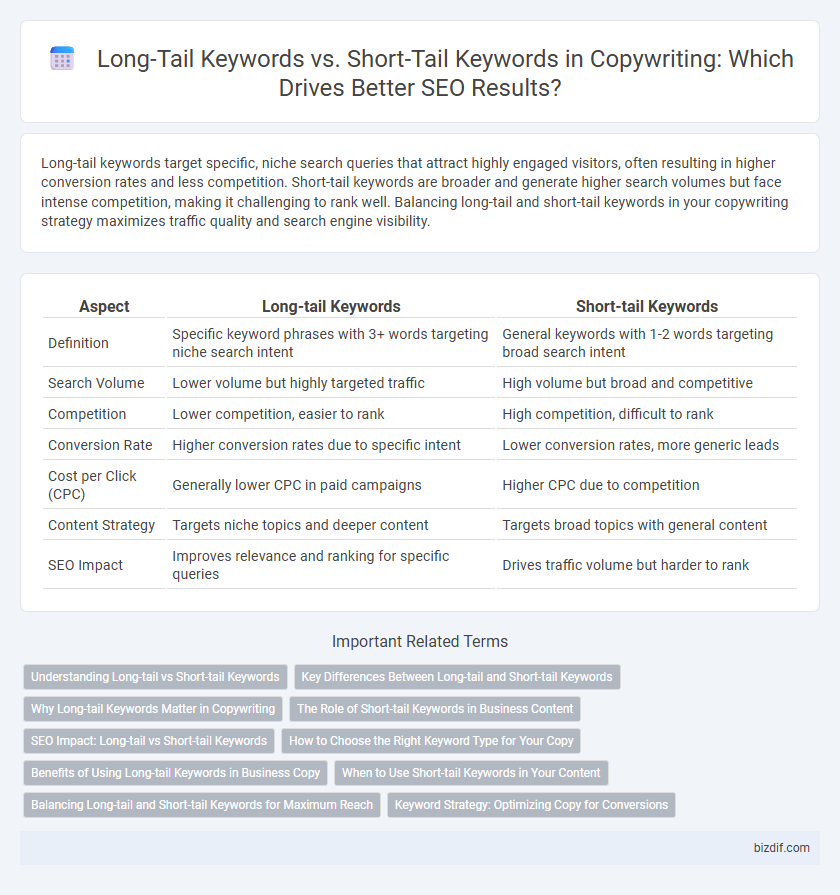Long-tail keywords target specific, niche search queries that attract highly engaged visitors, often resulting in higher conversion rates and less competition. Short-tail keywords are broader and generate higher search volumes but face intense competition, making it challenging to rank well. Balancing long-tail and short-tail keywords in your copywriting strategy maximizes traffic quality and search engine visibility.
Table of Comparison
| Aspect | Long-tail Keywords | Short-tail Keywords |
|---|---|---|
| Definition | Specific keyword phrases with 3+ words targeting niche search intent | General keywords with 1-2 words targeting broad search intent |
| Search Volume | Lower volume but highly targeted traffic | High volume but broad and competitive |
| Competition | Lower competition, easier to rank | High competition, difficult to rank |
| Conversion Rate | Higher conversion rates due to specific intent | Lower conversion rates, more generic leads |
| Cost per Click (CPC) | Generally lower CPC in paid campaigns | Higher CPC due to competition |
| Content Strategy | Targets niche topics and deeper content | Targets broad topics with general content |
| SEO Impact | Improves relevance and ranking for specific queries | Drives traffic volume but harder to rank |
Understanding Long-tail vs Short-tail Keywords
Long-tail keywords consist of three or more words and target specific search intents, resulting in higher conversion rates and lower competition compared to short-tail keywords, which are broader and consist of one to two words. Understanding the distinction helps copywriters tailor content to capture niche audiences and improve SEO effectiveness. Long-tail keywords drive more qualified traffic by addressing detailed queries, whereas short-tail keywords generate higher search volumes but with less precision.
Key Differences Between Long-tail and Short-tail Keywords
Long-tail keywords consist of longer, more specific phrases that target niche audiences, resulting in higher conversion rates and lower competition. Short-tail keywords are broader, high-volume search terms that attract more traffic but often face intense competition and lower conversion rates. Understanding these key differences allows marketers to strategically balance their SEO efforts for both immediate visibility and targeted engagement.
Why Long-tail Keywords Matter in Copywriting
Long-tail keywords matter in copywriting because they target specific search intents, leading to higher conversion rates and more qualified traffic. These keywords face less competition than short-tail keywords, making it easier to rank higher in search engine results pages (SERPs). Incorporating long-tail keywords enhances content relevance, improving SEO performance and attracting niche audiences effectively.
The Role of Short-tail Keywords in Business Content
Short-tail keywords drive high search volume and broad visibility, making them essential for increasing brand awareness and attracting diverse audiences in business content. While less specific, they establish foundational relevance in search rankings and capture traffic from general queries. Efficient use of short-tail keywords helps businesses position their core offerings prominently within competitive markets.
SEO Impact: Long-tail vs Short-tail Keywords
Long-tail keywords generate highly targeted traffic with lower competition and higher conversion rates, making them vital for niche SEO strategies. Short-tail keywords attract broader search volumes but face intense competition and often yield lower conversion rates. Balancing long-tail and short-tail keywords enhances organic search visibility and optimizes overall SEO impact.
How to Choose the Right Keyword Type for Your Copy
Choosing the right keyword type for your copy hinges on your target audience and campaign goals; long-tail keywords attract highly specific, intent-driven traffic, increasing conversion rates with less competition. Short-tail keywords drive higher search volume and brand visibility but face intense competition and broader user intent. Analyze your niche, competition, and buyer journey to balance these keyword types for maximum ROI in your copywriting strategy.
Benefits of Using Long-tail Keywords in Business Copy
Long-tail keywords drive highly targeted traffic by capturing specific search intent, resulting in higher conversion rates compared to short-tail keywords. These keywords face lower competition, allowing businesses to rank more easily on search engines, thereby increasing visibility and attracting qualified leads. Incorporating long-tail keywords into business copy enhances relevance, improves SEO performance, and delivers a strong return on investment through focused content marketing.
When to Use Short-tail Keywords in Your Content
Short-tail keywords are ideal for targeting broad search intent and driving high-volume traffic to your website. Use short-tail keywords in content when aiming to increase brand awareness or capture a wide audience during the early stages of the buyer's journey. These keywords perform best in homepage copy, category pages, and top-funnel blog posts where general discovery is the primary goal.
Balancing Long-tail and Short-tail Keywords for Maximum Reach
Balancing long-tail and short-tail keywords is essential for maximizing reach in copywriting; long-tail keywords target specific search intent with lower competition, driving highly qualified traffic, while short-tail keywords attract broader audiences and higher search volumes. Effective keyword strategy incorporates both to capture diverse user queries, improve search engine rankings, and enhance conversion rates. Prioritize long-tail keywords for niche targeting and short-tail keywords for brand visibility and traffic growth.
Keyword Strategy: Optimizing Copy for Conversions
Long-tail keywords target specific search intents with lower competition, driving highly qualified traffic that converts better than short-tail keywords, which are broader and less targeted. Incorporating long-tail keywords into your copy enhances relevance and attracts users closer to the point of purchase, boosting conversion rates. Strategic keyword placement balances short-tail terms for visibility and long-tail phrases for focused engagement, optimizing content for both search engines and user intent.
Long-tail Keywords vs Short-tail Keywords Infographic

 bizdif.com
bizdif.com